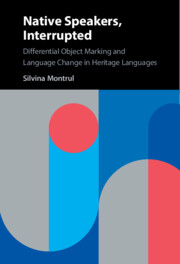Book contents
- Native Speakers, Interrupted
- Native Speakers, Interrupted
- Copyright page
- Dedication
- Contents
- Figures
- Tables
- Preface
- Abbreviations
- Introduction
- 1 On Heritage Speakers as Native Speakers
- 2 Structural Changes in Heritage Language Grammars
- 3 Differential Object Marking
- 4 Language Change and the Acquisition of Differential Object Marking
- 5 The Vulnerability of Differential Object Marking in Three Heritage Languages
- 6 Differential Object Marking in Spanish as a Heritage Language
- 7 Differential Object Marking in Hindi as a Heritage Language
- 8 Differential Object Marking and Clitic Doubling in Romanian as a Heritage Language
- 9 Comparing the Three Heritage Languages
- 10 Intergenerational Transmission
- Implications
- References
- Index
2 - Structural Changes in Heritage Language Grammars
Published online by Cambridge University Press: 15 December 2022
- Native Speakers, Interrupted
- Native Speakers, Interrupted
- Copyright page
- Dedication
- Contents
- Figures
- Tables
- Preface
- Abbreviations
- Introduction
- 1 On Heritage Speakers as Native Speakers
- 2 Structural Changes in Heritage Language Grammars
- 3 Differential Object Marking
- 4 Language Change and the Acquisition of Differential Object Marking
- 5 The Vulnerability of Differential Object Marking in Three Heritage Languages
- 6 Differential Object Marking in Spanish as a Heritage Language
- 7 Differential Object Marking in Hindi as a Heritage Language
- 8 Differential Object Marking and Clitic Doubling in Romanian as a Heritage Language
- 9 Comparing the Three Heritage Languages
- 10 Intergenerational Transmission
- Implications
- References
- Index
Summary
Compared to second language speakers who acquired the language later in life, heritage speakers often show native patterns in many areas of their grammar. Nevertheless, heritage speakers’ ultimate attainment in early adulthood is characterized by significant variability in their overall linguistic proficiency of the heritage language, which often falls outside the range of variation seen in monolingually-raised native speakers. Their native language abilities are dissociated by receptive and productive linguistic skills and within the language modules themselves. This chapter provide examples of the structural changes and differences commonly found in heritage language grammars, compared to the grammars of first-generation immigrants, who speak the same variety as the heritage speakers and who are the most comparable baseline. Heritage grammars are characterized by structural simplification, influence of the dominant language and slow and labored language processing during comprehension and production. Quantity and quality of input may drive processes of language change across generations. Although it has been suggested that changes observed in first-generation immigrants due to attrition are directly transmitted to heritage speakers it is argued that direct transmission from first to second generation is unlikely when considering the interaction of the intensity of the exposure and age of acquisition.
Keywords
- Type
- Chapter
- Information
- Native Speakers, InterruptedDifferential Object Marking and Language Change in Heritage Languages, pp. 39 - 81Publisher: Cambridge University PressPrint publication year: 2022
- 1
- Cited by



